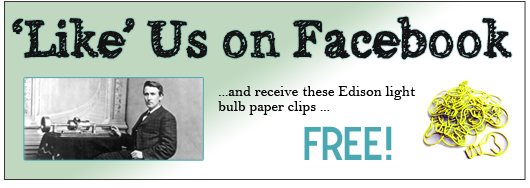Harry T. Roman's Blog, page 26
August 15, 2012
Thomas Edison – Man of the Millennium
You see writers expressing their thoughts about historical figures as being man or woman of the century. Magazines often laud seminal thinkers and statesman as person of the year. With Edison, Life magazine honored him as Man of the Millennium, a person who brought more value to the human race than any other, literally giving us our modern world and standards of living. His four great inventions were recorded sound, motion pictures, the electric light bulb and utility industry, and corporate R&D labs from which new products continue to flow in abundance.
Edison knew that intellectual property [IP] had great economic value. West Orange was built to perfect his invention factory concept, and tie it firmly to the business of new product development…. a 125 year-old entrepreneurial concept that has kept the industrial revolution of the mid-to-late 1800s alive and flourishing to this day. It is the reason he defended his IP so vigorously. His influence on succeeding generations of inventors and entrepreneurs is without question; and continues to inspire new generations. His image is the national symbol of great new things.
Literally, the West Orange lab is the “mother ship of American innovation”. A 2012 report from the Commerce Department indicated that 40 million U.S. jobs are linked to intellectual property use. Those IP intensive jobs account for almost $5 trillion to U.S. GDP, about 30% of our current economy. Furthermore, this report found that exports from IP intensive industries totaled $775 billion in 2010, about 61% of merchandise exports. Another important finding showed that for every two jobs in IP intensive industries, another job was generated elsewhere in the economy. Thomas Edison is the taproot for all this.
No doubt this Thomas Edison fellow made quite a difference in the world, wouldn’t you say? Take a quick tour of some very interesting monuments that have been erected in his honor. This photo below is a memorial in Kyoto, Japan to Mr. Edison and his use of Kyoto bamboo as an early bulb filament. Many nations celebrate Mr. Edison and teach their school children about what this great man accomplished.
Henry Ford had this memorial below commissioned in 1948 and located at Greenfield Village, in Dearborn Michigan. Ford and Edison were close friends, and Ford was heavily influenced in his own inventions and automobile industry operation by his life-long friendship with Edison.
Honoring his great iron ore mining work, in the far northern area of New Jersey [Sparta-Ogdensburg], this memorial was erected in 1980. Later, the rock crushing technology invented here was used for making Edison’s own popular construction cement [which was used in the building of the original Yankee Stadium and his business to build low cost concrete homes].
Edison played a pivotal role during WWI in assisting the nation with the development of defenses against the German U-boat threat. Working with national teams of scientists, inventors, technologists and engineers, this effort eventually led to the formation of the Naval Research Labs in the early 1920s; and served as the model for the Manhattan Project in WWII; and subsequently the highly respected U.S. national labs. This memorial to Edison below is located at the entrance to the Naval Research Labs.
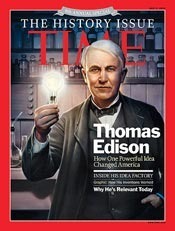 Thomas Edison – Man of the Millennium – said … “I find out what the world needs. Then I go ahead and try to invent it.”
Thomas Edison – Man of the Millennium – said … “I find out what the world needs. Then I go ahead and try to invent it.”Time® is a registered trademark of Time Inc.
August 1, 2012
Inventions Thomas Edison Would Love: Biomass Conversion
Solar energy applications are not just the solar electric panels that convert sunlight to electricity, or the majestic large, spinning, wind turbines we see on the great plains or in offshore clusters. Solar applications also include the use of biomass…..organic materials grown and then processed into fuel or useful products.
Here is what the National Renewable Energy Laboratory [NREL] has to say about biomass applications:
Biofuels — Converting biomass into liquid fuels for transportation
Biopower — Burning biomass directly, or converting it into gaseous or liquid fuels that burn more efficiently, to generate electricity
Bioproducts — Converting biomass into chemicals for making plastics and other products that typically are made from petroleum
Biofuels can be used to supplement our energy sources, replace existing petrochemical energy sources, reduce dependence on foreign sources of energy, and reduce the environmental impact/greenhouse gas emissions of petrochemical energy use.
Every time the price of a barrel of oil goes up a dollar, it costs the Navy $31 million in extra fuel costs. The U.S. military is very interested in alternative fuels — in particular, the wood-based biofuels being researched and produced at the University of Maine. Check out this amazing process.
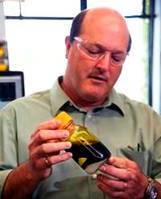
Professor Clayton Wheeler of U of Maine
Professor Clayton Wheeler of U of Maine holding a bottle of biofuel made from wood materials. This biofuel can be used as is as a substitute for heating oil or refined a bit more for use as a premium transportation fuel/jet fuel.
It is fascinating to remember Thomas Edison experimented with biomass back in the late 1920s, trying to find common plant materials that could be processed to become a viable substitute for rubber. In his painstaking years of work, Edison and his staff evaluated about 17,000 candidate plant species, to develop a giant cross-bred goldenrod plant that could grow as tall as 12 feet; and whose structure contained about 12% rubber. In 1927, Edison, Henry Ford, and Harvey Firestone formed the Edison Botanic Research Corporation of Fort Myers. Plants were collected in Florida and throughout the southern United States by field collectors. Plants were grown under controlled conditions in Florida and at Edison’s laboratories in West Orange, New Jersey.
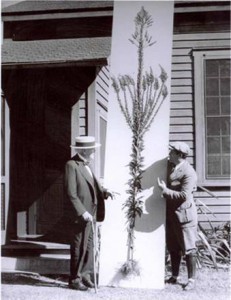
Edison in Fort Myers in 1931, along with his giant goldenrod plant, later named after him, Solidago edisoniana.
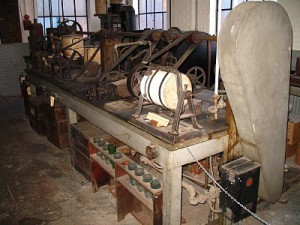
The plant processing equipment Edison used in his West Orange Chemistry Lab to facilitate the extraction of latex rubber from his goldenrod and other candidate plants.
Editor’s Deep Dive:
http://www.nrel.gov/learning/re_biomass.html
http://www.ucsusa.org/clean_energy/our-energy-choices/renewable-energy/how-biomass-energy-works.html
http://www.eia.gov/kids/energy.cfm?page=biomass_home-basics
http://www.biofuelsjournal.com/articles/University_of_Maine_Researchers_Work_to_Develop_Biomass_Jet_Fuel_For_U_S__Military_-122983.html
 Thomas Edison said … “I’d put my money on the sun and solar energy. What a source of power! I hope we don’t have to wait until oil and coal run out before we tackle that. I wish I had more years left.”
Thomas Edison said … “I’d put my money on the sun and solar energy. What a source of power! I hope we don’t have to wait until oil and coal run out before we tackle that. I wish I had more years left.”Time ® is a registered trademark of Time Inc.
July 23, 2012
Thomas Edison Communicates with the World
If you look real close, you see a big underlying theme in a great deal of Edison’s work. Let’s explore Thomas Edison, communications guy.
His first love was telegraphy, starting out as an itinerant telegrapher, roaming the Midwest during the Civil War. Establishing himself as an inventor, he set to making major improvements, increasing the capability of telegraph lines; making it possible to send and receive multiple messages over the same line, radically increasing the value of the telegraph’s initial investment, heretofore, only capable of one message at a time. Soon, he gives the world the stock ticker, a kind of time-shared telegraph service for paying business customers.
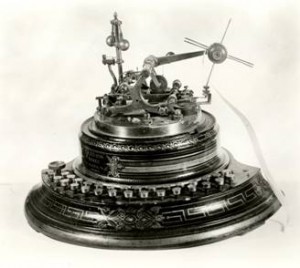
Edison stock ticker
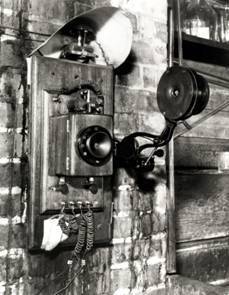
Carbon button microphone mouthpiece on phone in Edison workshop
In a game of one-upmanship with Alexander Graham Bell, Edison makes a major improvement to Bell’s telephone. Edison’s carbon button microphone used in the mouthpiece of the telephone allows better voice clarity and transmission over longer distances. This innovation was incorporated in phones for the next 100 years. Soon thereafter, Edison stuns the world with his phonograph and recorded sound, totally revamping our concept of music and personal communication….making it portable and a one-on-one experience. Previously, all music was performed live and most likely a group or audience event. In the world’s first recording studio, Edison makes and markets his recordings to the world.
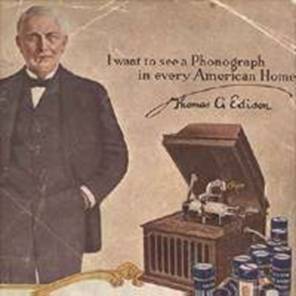
Edison Phonograph Advertisement
Edison later does for the eyes what his phonograph did for the ears, and gives us motion pictures; and the world’s first motion picture studio…the famed Black Maria. Again, Edison invents a new way for humans to communicate and reach out to each other. Later, his pictures and recorded sound would be combined into what we take for granted today.
By the way, as a young boy working on the trains, young Tom sold a variety of snacks to riding customers. He also created his own newspaper on-board the train and sold it to riders, so here again is a very early link in his communication theme. His later electric distribution system would set the stage for electrification of the world, making recorded sound and motion pictures that much easier to implement, today powering the telecommunications revolution and the digitization of all of it in convenient computer and hand-held form. A fellow by the name of Steve Jobs combined much of Mr. Edison’s innovations in recorded sound, motion pictures, texting [telegraphy] and telephony into a single hand-held device, making it all highly portable.
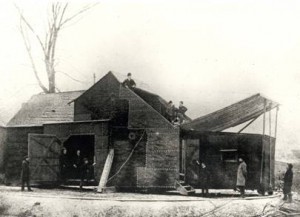
The Black Maria

Steve Jobs and the iPad, a celebration of Edison technology incorporated within
And yes, Tom was quite hearing impaired to boot, which did not seem to stop his recorded sound work in the least.
 Thomas Edison says…..“My philosophy of life is my work for people’s happiness, and I must dig out the secrets of nature and apply them. In this short life I do not know of any better way to live.”
Thomas Edison says…..“My philosophy of life is my work for people’s happiness, and I must dig out the secrets of nature and apply them. In this short life I do not know of any better way to live.”Time ® is a registered trademark of Time Inc.
July 10, 2012
Celebrating Entrepreneurship at the Thomas Edison Labs
Entrepreneurs built our nation, took risks, created capital and jobs, and launched new industries. Our economy today is driven by innovative small to intermediate size business owners who see opportunities, and move forward quickly to satisfy new and developing markets. The telecommunications revolution is taking entrepreneurial activity and super-charging it. Risk-taking is alive and well in our country; and under the proper conditions thrives.
Michael Simmons is a charismatic leader and motivational speaker for young entrepreneurs. Through Empact Michael’s work focuses on facilitating a culture of entrepreneurship in communities across the world through exposure, celebration and early stage startup support.
Empact has held over 400 events exposing young people to entrepreneurship through its Extreme Entrepreneurship Tour, supporting early stage entrepreneurs through its Virtual Speaker Series and JourneyPage Virtual Business Incubator; and celebrating the role of young entrepreneurs through its annual Empact100 list & showcase of top young entrepreneurs age 30 and under. In short, Empact celebrates entrepreneurship, empowering young folks to join the fun.
Recently, Michael and his entrepreneurial friends came to visit the legendary Thomas Edison National Historical Park [TENHP] in West Orange, NJ – to see where modern day entrepreneurship was honed to a fine edge. They were invited by John P. Keegan, Chairman & President of the Edison Innovation Foundation, who gave a welcoming address to the attendees, and personally conducted a tour of the famed Edison Labs. You can learn more about Edison and the Foundation at www.thomasedison.org and on Facebook; and also at Pinterest.
Here at the Edison Labs, now celebrating its 125th anniversary, Edison forever merged invention and marketing to create a commercial powerhouse of new product development, what we have come to accept as “progress”. His invention factory became the model for R&D labs the world over, converting invention from a cottage industry to a commercial and scientifically conducted endeavor. So strong was Edison’s influence on commercialization that today, 81 years after the great inventor’s death in 1931, his inventions and industries launched, account for about 10% of the national economy.
Michael and friends were able to see the famed Edison library and business office, tour the invention factory complex, see the historic Edison home [Glenmont] and examine his antique cars and garage. This engaging and cutting edge group of young entrepreneurs provided great feedback and ideas concerning where TENHP and the Edison Foundation could possibly grow in the next few years.
If Tom were here, he would have a declared the day a great success!
To all you entrepreneurs out there, struggling to make your dream come true, remember what Edison said …”Fail your way to success.”
Editor’s Deep Dive
http://upstart.bizjournals.com/news/wire/2011/10/28/young-gifted-and-entrepreneurial-empact-is-looking-for-you.html
http://www.youtube.com/watch?v=zDNEO_PRn7k
http://www.feepledge.com/news.php
http://www.empactsummit.com/
 Thomas Edison said … “Many of life’s failures are experienced by people who did not realize how close they were to success when they gave up.”
Thomas Edison said … “Many of life’s failures are experienced by people who did not realize how close they were to success when they gave up.”Time ® is a registered trademark of Time Inc.
June 26, 2012
Edison Day 2012
The first Saturday in June is always celebrated as Edison Day at the Thomas Edison National Historical Park in West Orange, NJ. Here at the largest and most compete technological museum on the planet, many families and visitors come to partake in the many free activities that day. That is the way it was on June 2nd , as 667 visitors came to the site, including Edison’s historic home, Glenmont. Here are some of the activities that took place.
Visitors were treated to a variety of musical sounds and live recordings captured using original Edison phonographs. The music was recorded and played back on cylinders so folks could hear what music sounded like 125 years ago. Folks also toured Edison’s recording studio, the first of its kind in the world. They were able to see the big reproduction of Edison’s Black Maria, the world’s first motion picture studio.
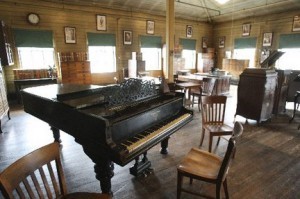
Edison recording studio-3rd floor of Invention Factory Building
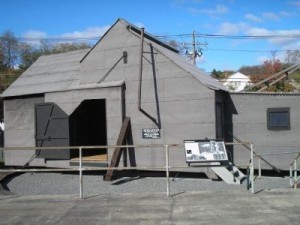
The Black Maria replica-world’s first motion picture studio
Visitors were also treated to some interesting alternate energy technology demonstrations and tours. Since 2005, the lovely Edison mansion, Glenmont, has been space conditioned with a geothermal heating and cooling system in the basement of the home. Using heat pumps, Glenmont is cooled for half the year with that captured heat stored in the Watching Mountain range upon which Glenmont rests. For the remaining half of the year, that stored mountain heat is re-captured from its deep underground storage and used to heat the home. Like a giant energy bank, this unique system keeps the conditions [temperature and humidity] just right in the home at all times, thereby preserving the artifacts for many generations to enjoy. Those visitors who saw the geothermal system also joined hundreds of others who toured the home itself and its original Victorian period motif-lots of “OOhhs and Ahhs” you can bet!

Heat pumps, the heart of the geothermal heating/cooling system
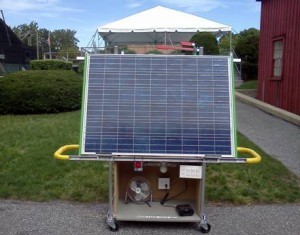
200 watt solar panel display
The site showed-off a recent acquisition, which proved to be quite popular, a working solar energy system, conveniently mounted on a portable, rolling cart. In bright sunlight, this display wowed visitors as it powered a large light and a fan. Folks were treated to detailed descriptions about how solar energy systems are being used today and the potential for this technology. Edison was a big fan of solar and wind technologies, something many visitors did not know. Another very interesting display was an electric racing car built in the style of the famous Lotus7 vehicle, a car designed and made from scratch by local West New York High School students. This car, supported by the Edison Innovation Foundation, was previously shown at the April New York Auto Show. The attention grabber was the beautiful Edison image on the front of the vehicle. Edison was a big supporter of electric vehicles, and the
Lotus7 was on display in the Edison garage next to the great inventor’s electric vehicles from the 1895-1915 period.
 Next year, 2013, Edison Day will be on Saturday June 1st. See you there!
Next year, 2013, Edison Day will be on Saturday June 1st. See you there!
Thomas Edison said … “I find out what the world needs. Then I go ahead and try to invent it.”
Time ® is a registered trademark of Time Inc.
June 14, 2012
Inventions Thomas Edison Would Love: Solar Storage Technology
There is another large scale way to use the sun’s energy, an alternative to the solar cell or photovoltaic systems now sprouting on home roofs or in larger ground installations. Sometimes called the solar power tower system, this large scale utility like solar application found its birth in the late 1970s/early 1980s. A tall tower [probably 400-600 feet or so] supports a high temperature steam boiler, which is heated by the automated positioning of solar mirrors [heliostats] that intensely focus the sun’s light. High temperature steam generated in the boiler is then used to run traditional utility-grade, turbo-electric generating equipment, much like a central station power plant of today.
Photo of Solar Power Tower (source: Internet)
![Photo of heliostats: polished, sun-tracking mirrors [source: Internet]](https://i.gr-assets.com/images/S/compressed.photo.goodreads.com/hostedimages/1381484735i/4932480.jpg)
Photo of heliostats: polished, sun-tracking mirrors (source: Internet)
The key difference in this design from its solar cell-photovoltaic alternative is the use of a high temperature storage medium to run the plant when the sun is not shining. In effect, this solar alternative is a 24-hour system, providing all-day, clean electricity that can be dispatched by a utility. Today, solar power tower systems have been built in the 5-20 MW size range with plans for 100 MW systems, usually located in desert areas where sunshine is plentiful, and the skies are very clear.
Key to this plant’s operation and economics is the storage medium, usually a “eutectic salt”, a compound that absorbs and releases quantities of heat as it changes from a liquid to a solid. You know those blue compounds in plastic containers you chuck into the freezer to solidify that you use the next day to keep things cold for your picnic..that’s the idea…only super-size the magic liquid up into many, many gallons. Like a modern day Thomas Edison, when he went through 15,000-20,000 experiments to find the right electrolyte for his storage battery, a company called Halotechnics [http://www.halotechnics.com/] is searching for just the right kind of eutectic salt. So far, over 14,000 chemical combinations have been evaluated.
An early promising storage medium known as Saltstream™ 565 is now being offered by the company for commercial use. It is 20% cheaper than existing storage compounds, using less expensive salts. Saltstream™ materials utilize eutectic mixtures with drastically reduced melting points, reducing the risk of freezing and expanding the operating range of the fluid. It would allow solar plants to operate at greater temperatures and store more heat in the chemical structure of the salt. The materials they have devised, which include new mixtures of salts as well as new forms of molten glass materials, could be key to making solar-thermal power plants cheap and reliable enough to compete with fossil fuels on a large scale.
Editor’s Deep Dive:
http://en.wikipedia.org/wiki/Solar_power_tower
http://www.wipp.energy.gov/science/energy/powertower.htm
http://mashable.com/2011/04/12/ivanpah-google-solar-energy/
http://en.wikipedia.org/wiki/Thermal_energy_storage
http://en.wikipedia.org/wiki/M%C3%A1ria_Telkes
 Thomas Edison said … “I’d put my money on the sun and solar energy. What a source of power! I hope we don’t have to wait until oil and coal run out before we tackle that.”
Thomas Edison said … “I’d put my money on the sun and solar energy. What a source of power! I hope we don’t have to wait until oil and coal run out before we tackle that.”Time ® is a registered trademark of Time Inc.
June 4, 2012
Edison Patents: Blueprints for Today’s Technology Advances
Patents are the lifeblood of competitive industry, the intellectual knowledge and know-how of a company – the blueprints for its key products and processes. All inventors protect their intellectual property, realizing the great value it has in keeping them a vibrant force in the world marketplace. Thomas Edison knew too. His 1093 patents are testimony to his discipline of protecting his intellectual property, which helped ignite a firestorm of patent applications worldwide that shows no sign of slowing down.
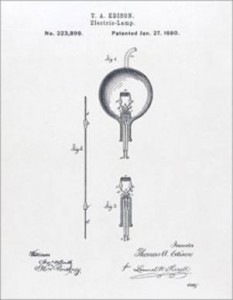
Electric light bulb
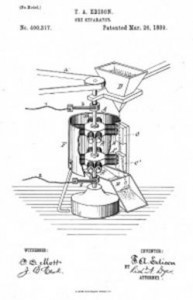
Ore crushing apparatus
Close to 70% of the growth of our economy is directly attributable to science, technology, and invention. This is the feedstock for entrepreneurs and risk-takers who will follow in Edison’s footsteps to bring the marketplace the products and services desired. Patents are the powerhouses of economic growth-the highly charged fuel that energizes our globally competitive environment.
Patents derive from old English law, dating back to when kings and queens issued royal charters for a manufacturer to supply certain products for a specified period of time. Our founding fathers gave the power to the first Congress to establish a patent office, knowing full well the economic power of patents and the strong incentive it would supply to America’s inventors and innovators. It may be the oldest U.S. government office, generating a positive cash flow from the fees it charges inventors to establish and maintain their patents. Some of our most cherished founding fathers were inventors, Franklin and Jefferson as classic examples … they had to be to tame a new country, solving problems at every turn. Washington was an entrepreneur, in the marketing and development of land, and the distilling of spirits.
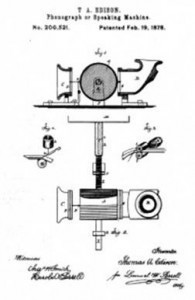
Recorded sound
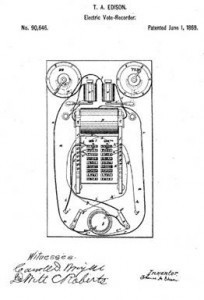
Vote recorder
Over 8,000,000 patents have been awarded since 1792 [the formal date of the establishment of the U.S. Patent and Trademark Office-USPTO. You can take a quick and easy look at America’s patents by going to www.uspto.gov, http://www.google.com/patents, or http://www.freepatentsonline.com/. These sites are a great way for students and teachers to see how just about anything they can think of in their daily lives is affected somehow by a patent currently in force, or from one in the past. Traditionally, about 65-70% of the U.S. patent applications filed, result in granted or issued patents. [Did you know that Thomas Jefferson was the first head of the US PTO?]
Here is another fascinating fact. When Edison was born in 1847, the USPTO had by that time issued a total of about 5,000 patents. By 1935, the 2,000,000th patent was issued; by 1976 the 4,000,000th patent; and by 2011, the 8,000,000th. Edison died in 1931, but what an industrial revolution he had not only witnessed but played a major role in implementing. His work continues to inspire inventors and entrepreneurs worldwide today.
It would seem that Edison’s “invention factory” process has paid off quite nicely. Major world economies know the value of patents, and use them to maintain and advance their competitive positions, seeing intellectual property as a strategic resource. Of all of Edison’s great inventions, his invention factory [R&D labs] may be his greatest as it has affected, and keeps on affecting, so much of the world economy, propelling it relentlessly forward. Thanks Tom!
 “To invent, you need a good imagination and a pile of junk.”
“To invent, you need a good imagination and a pile of junk.”Time ® is a registered trademark of Time Inc.
May 30, 2012
See the new Thomas Edison Lotus7 Electric Car
It’s not a big classroom/workshop at West New York Memorial High School, but there is magic happening there. Students are learning about Thomas Edison, alternate fuels, and building an all-electric vehicle…. all at the same time. In fact, the students not only built a Lotus7 from an old set of blueprints, they showed the car at the prestigious April 2012 New York Auto Show. You can see this vehicle too at the upcoming annual Edison Day celebration … read more below.
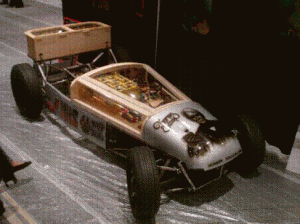
The Edison electric Lotus7-note batteries under hood and behind seat area.
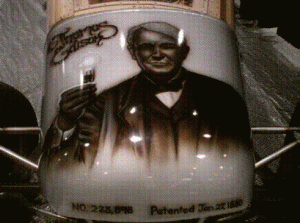
Showing off that Edison image!
Ron Grosinger, 34, a teacher at the high school for seven years, has roughly 30 students enrolled in his Alternative Fuel Club and Inventors and Craftsmen classes. “My job is to teach students how to prepare for alternative fuels,” Grosinger said. “There’s no silver bullet. The answer (for fuel efficiency) isn’t investing completely in electrical or biodiesel cars. We need to utilize both.” Ron teaches his enthusiastic students about engineering, metals, math, science, alternate fuels, and to use their heads and hands to create something new. It’s a crash course in Reality 101, and the students respond whole-heartedly, anxious to learn…and do.
This is not the first alternate energy car attempted by Ron Grosinger and his students. Two previous classroom projects resulted in a biodiesel conversion car and a battery retrofit to another car. The Lotus7 build was their first ground-up build, soup to nuts. The West New York Board of Education contributed roughly $10,000 toward the project, and the Edison Innovation Foundation contributed $4,000.
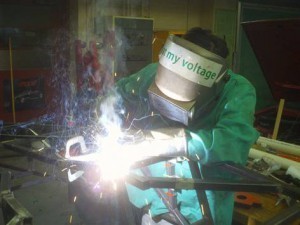
Student welding the vehicle chassis
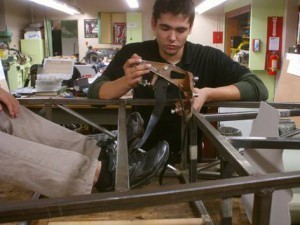
Installing the pedal mounting
On June 2nd (Edison Day) the vehicle will be displayed at the Thomas Edison National Historical Park site in West Orange, NJ . Visitors are welcome to enjoy the free all day celebration festivities at the park, from 10:00 am to 4:00pm; and also see the vehicle. The Lotus7 will reside in the historic Edison garage, alongside several vintage electric vehicles dating from the 1911-1914 time frame. The old vehicles were driven by Mrs. Edison on her jaunts around town and on her way to her many civic and philanthropic activities.
This is the kind of education Thomas Edison argued for during his lifetime, real-world engagement on projects that made students design, think, create and invent. Today we call this STEM education, Science Technology Engineering and Math; and it looks like Ron Grosinger and his kids are right there in the thick of it!

Wonder what Ron and his team have planned for next year?
___
“The thing with which I lose patience most is the clock. Its hands move too fast.
Time ® is a registered trademark of Time Inc.
May 21, 2012
Thanks to Thomas Edison and All Inventors!
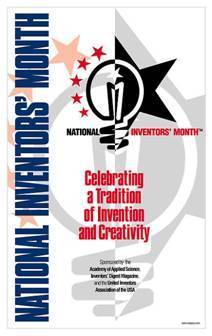
National Inventors Month began was started in 1998 by the United Inventors Association of the USA (UIA-USA), the Academy of Applied Science, and Inventors' Digest magazine.
It’s National Inventor’s Month, so thank an inventor you know because their hard work and the intellectual property developed has gone a long way toward improving our economy and lives. Consider this.
A 2012 report from the Commerce Department [“Intellectual Property and the U.S. Economy: Industries in Focus” - April 2012] indicated that 40 million U.S. jobs are linked to intellectual property [IP] use. Those IP intensive jobs account for almost $5 trillion to U.S. GDP, about 35% of our current economy. Furthermore, this report found that exports from IP intensive industries totaled $775 billion in 2010, about 61% of merchandise exports. Another important finding showed that for every two jobs in IP intensive industries, another job was generated elsewhere in the economy.
Some of the most IP-intensive industries surveyed by the report were computers and peripheral equipment, audio and video equipment manufacturing, newspaper and book publishers, plus pharmaceuticals and medicines.
Major conclusions to be derived from this important report:
A significant portion of our economy is based on invention and IP
IP is a way to create great export economics
IP generates jobs
Streamline the patent process to promote faster patent awards
Encourage invention and new product development
Make sure students have the opportunity to master STEM activities in schools
Protection of our IP is another important conclusion, because international IP theft robs us of jobs
Teaching young folks about Thomas Edison is inspirational, and totally applicable in STEM classrooms
Invention is directly responsible for our high standards of living.
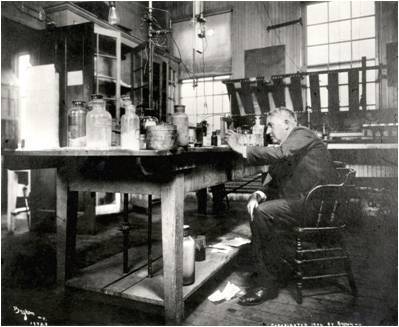
Learn more about America’s great inventors, including the big guy himself, probably an inspiration to many inventors … Thomas Edison. Talk to your kids and their teachers too. Make sure this important message gets out!
 “My desire is to do everything within my power to free people from drudgery and create the largest measure of happiness and prosperity.”
“My desire is to do everything within my power to free people from drudgery and create the largest measure of happiness and prosperity.”Time ® is a registered trademark of Time Inc.
Harry T. Roman's Blog
- Harry T. Roman's profile
- 2 followers


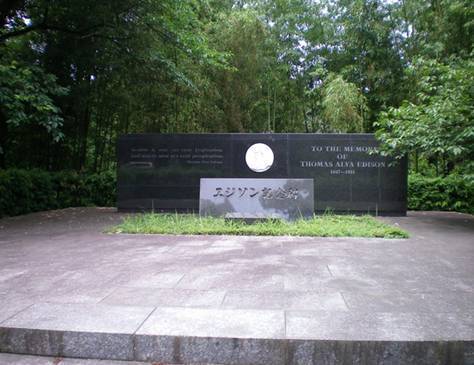
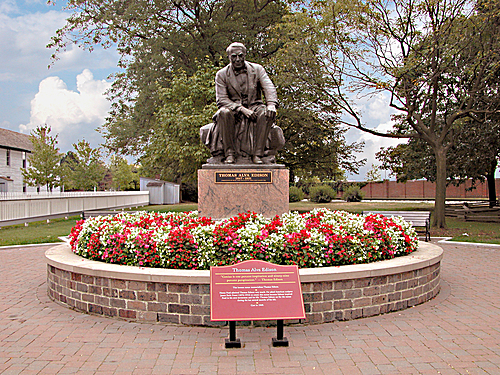
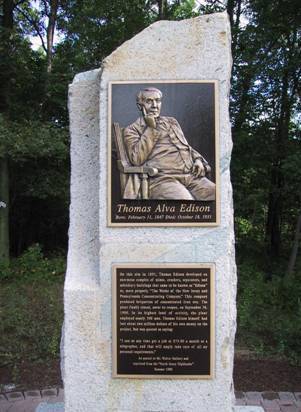
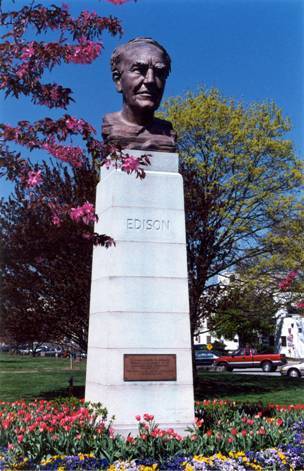
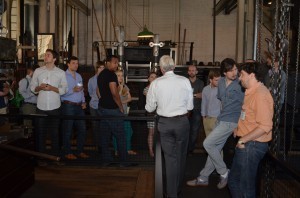
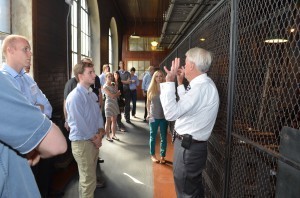
![Photo of Solar Power Tower [source: Internet]](https://i.gr-assets.com/images/S/compressed.photo.goodreads.com/hostedimages/1381484735i/4932479.jpg)
